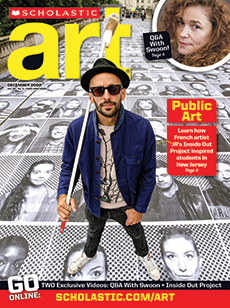What do posters, graphic T-shirts, and greeting cards have in common? They’re all made using printmaking techniques. Printmaking is a medium in which an image is transferred from one surface to another using pigment. The image, or print, is reproduced, and when it is reproduced more than once, the collected works are called an edition. Each version is an artwork on its own—even if the artist makes hundreds!
Historians aren’t sure when humans started printmaking. But some believe that tens of thousands of years ago, prehistoric people used stenciling methods, a technique used in printmaking, to record the shapes of hands on cave walls. They likely achieved this by placing a hand against a cave wall and blowing paint around it through a tube.
Today there are many types of printmaking. One of the oldest is woodcut printing, a type of relief printing. To make a woodcut print, an artist carves an image’s negative space into a block of wood. He or she adds pigment to the positive space using a brayer. Then pressure is applied using a press or another tool to transfer the inked image onto paper.
At the turn of the 20th century, some contemporary printmakers started using linoleum for their relief prints instead of wood. Today linoleum block prints, or linocuts, are common, but many artists still carve their images into wood.
What do posters, T-shirts with images on them, and greeting cards have in common? They are all made using printmaking techniques. In printmaking, an image is created with ink or another pigment. The artist copies the image by transferring it from one surface to another. This is called a print. Multiple copies of the same image are called an edition. Each copy is an artwork. That’s true even if the artist makes hundreds!
Nobody knows for sure when humans started printmaking. Some experts believe that prehistoric people made prints tens of thousands of years ago. They may have recorded the shapes of hands by placing them against cave walls and blowing paint around them through a tube. This method is similar to stenciling, which is used in printmaking today.
There are many types of printmaking. One of the oldest is woodcut printing. To make a woodcut, an artist carves an image’s negative space into a wood block. Then he or she uses a brayer to apply pigment to the image’s positive space. The artist presses paper against the wood block to transfer the image.
At the turn of the 20th century, some artists started using linoleum instead of wood for their block prints. Linoleum block prints, or linocuts, are popular today. But many artists still work with woodcuts.
